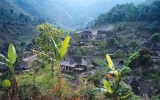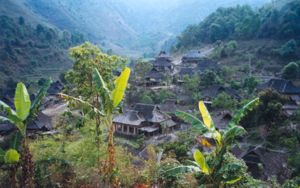
Blang
Encyclopedia

Ethnic group
An ethnic group is a group of people whose members identify with each other, through a common heritage, often consisting of a common language, a common culture and/or an ideology that stresses common ancestry or endogamy...
. They form one of the 56 ethnic groups officially recognized by the People's Republic of China
People's Republic of China
China , officially the People's Republic of China , is the most populous country in the world, with over 1.3 billion citizens. Located in East Asia, the country covers approximately 9.6 million square kilometres...
.
Language
The Blang language belongs to the Palaung-WaPalaungic languages
The nearly thirty Palaungic or Palaung–Wa languages form a branch of the Austro-Asiatic languages.Most of the Palaungic languages lost the contrastive voicing of the ancestral Austro-Asiatic consonants, with the distinction often shifting to the following vowel...
branch of the Mon–Khmer family of languages. Within the Palaung-Wa branch, Blang belongs to the Waic subgroup, which also contains the languages of the Wa
Va people
The Va nationality lives mainly in Northern Burma, in the northern part of Shan and eastern Kachin States, near and along the border with China. Their defacto capital is Pangkham in the unofficial Wa State in North Eastern Shan state. The majority of the Va live in Burma...
and Lawa
Lawa people
Lawa are an ethnic group in Laos and northern Thailand. They lived there before Thai people arrived. Today they live often in their traditional way of life, often professing animism. As the other mountain ethnic groups of Thailand, they are known for extraordinary craft skills...
peoples in addition to Blang. Some Blang also speak the Chinese language
Chinese language
The Chinese language is a language or language family consisting of varieties which are mutually intelligible to varying degrees. Originally the indigenous languages spoken by the Han Chinese in China, it forms one of the branches of Sino-Tibetan family of languages...
and Dai
Dai people
The Dai peoples is one of several ethnic groups living in the Xishuangbanna Dai Autonomous Prefecture and the Dehong Dai and Jingpo Autonomous Prefecture , but by extension can apply to groups in Laos, Vietnam, Thailand, and Burma when Dai is used to mean specifically Tai Lue, Chinese Shan or even...
languages in addition to speaking Blang. Two systems of writing based on the Latin alphabet
Latin alphabet
The Latin alphabet, also called the Roman alphabet, is the most recognized alphabet used in the world today. It evolved from a western variety of the Greek alphabet called the Cumaean alphabet, which was adopted and modified by the Etruscans who ruled early Rome...
have been developed: 'Totham' in the Xishuangbanna and 'Tolek' from Dehong and Lincang.
History
Chinese ethnographers identify the Blang as descendants of an ancient tribe known as the "Pu" (濮), who lived in the Lancang river valley during ancient times. It is believed that these people were one branch of a number of peoples that were collectively known to the ancient Chinese as the Bǎipú (百濮, literally "Hundred Pu").Culture
Traditionally, the Blang considered teeth blackened by chewing betel nutBetel nut
The Areca nut is the seed of the Areca palm , which grows in much of the tropical Pacific, Asia, and parts of east Africa. It is commonly referred to as "betel nut" as it is often chewed wrapped in betel leaves.-Description:...
s a beauty characteristic.
The women usually dress in jackets with black skirts. The men had tattoos in the torso and the stomach. They dressed in wide black trousers and jackets buttoned to the front. Often they would wear turbans of either white or black fabric.
The houses of the Blang are made out of bamboo and usually consist of two floors. The first floor is designed as a warehouse for food and a stable for livestock animals, such as chickens, whereas the second is designed to house the family. The chimney is located in the center of the house.
The Blang are traditionally divided into small clans, with each clan owning its own land. Every Blang town has its own cemeteries, which are divided by clans. The deceased are buried, with the exception of those who perished due to unnatural causes. In this case they are cremated.
Religion
Traditionally the Blang are mostly animistsAnimism
Animism refers to the belief that non-human entities are spiritual beings, or at least embody some kind of life-principle....
, in addition to ancestor worship.
The Blang also combine their native beliefs with Theravada Buddhism.

